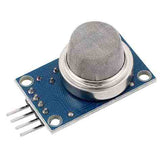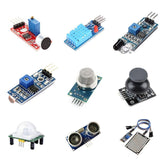Discover the Power of MQ2 Gas Sensors: Your Ultimate Guide
Summary
Unveil the potential of MQ2 Gas Sensors with our comprehensive guide! Delve into the workings of these innovative devices, understanding their mechanisms and applications. From detecting various gases to ensuring safety in diverse environments, explore the versatility of MQ2 Gas Sensors. Distinguish between module versions and standalone sensors, and uncover viable alternatives. Plus, gain valuable insights into maintenance and troubleshooting tips to maximize efficiency. Join us as we unravel the realm of MQ2 Gas Sensors, empowering you with knowledge and solutions for a safer, smarter tomorrow!
Introduction
Imagine being at home enjoying an unwinding evening and then suddenly smelling gas; what are you to do? Panic? Call for help?
This is where gas sensors come in; they detect and measure concentrations of gases present in their surroundings to produce electronic signals to ensure safety, monitor air quality or control industrial processes - they truly serve as unsung heroes in many safety and environmental monitoring systems!
Have you ever found yourself asking how factories avoid major gas leaks, or how your home's smoke detector operates?

Gas sensors play a significant role in these situations - be it protecting us against carbon monoxide poisoning at home, or monitoring levels of toxic and combustible gases at work to ensure compliance with safety regulations and prevent workplace accidents.
Gas sensors act like watchful guardians who watch for potential danger. Now we will meet the hero of our show: the MQ2 smoke sensor!
People often turn to it to detect LPG, methane, alcohol, hydrogen and smoke; known for its reliability and sensitivity as a type of chemiresistor, you can measure its change in resistance when exposed to gases to determine their presence and amount in the air - just think of it like having an extremely sensitive nose that can identify trouble long before you do!
What Is an MQ2 Gas Sensor?
An MQ2 gas sensor can be defined as an electronic device which detects various gas concentrations in the atmosphere, with primary functions of detecting the presence of potentially explosive or hazardous gases such as those emitted by combustion processes and providing alarms or safety measures in response. Think of it like having your own personal watchdog for dangerous gasses!
Key Features and Specifications
The MQ2 sensor operates on 5V DC power supply and can detect gases between 200-10,000 parts per million (ppm).

It consists of a heating element and sensing material which are essential in its functioning; in addition, this sensor stands out with its quick response time, high sensitivity, long life cycle and long battery life - giving users peace of mind 24/7!
Gas Types Detected by MQ2 Sensor
The MQ2 gas sensor can detect multiple gases, including:
- LPG (liquefied petroleum gas)
- Methane
- Propane
- Hydrogen
- Alcohol
- Smoke Carbon Monoxide.
This versatile gas sensor makes an exceptional asset in various applications ranging from home safety systems to industrial gas monitoring setups.
Working Principle
Now let's take a peek inside the MQ2 sensor: it consists of a sensing element crafted out of SnO2-coated aluminium-oxide ceramic sensing element enclosed within an stainless steel mesh to protect it from damage while permitting gases to pass freely - effectively acting like a high-tech fortress with its drawbridge down, ready to detect intruders.


Role of the Sensing Element
We heat the sensing element to high temperatures, which allows oxygen molecules to adhere to its surface and have an immediate impact on its electrical properties and behaviour - think of it like an attracted plate that attracts certain molecules that change its behaviour significantly over time.
Mechanism of Gas Detection
Reducing gases react with the adsorbed oxygen molecules on sensors when they come in contact, lowering surface density of oxygen and allowing electrons to move more freely through sensing material, thus decreasing resistance and permitting measurement. In essence, harmful gases alter resistance on sensing materials which allows measurement.
Voltage Divider Network
A voltage divider network measures the sensor output and changes resistance based on gas presence to affect output voltage proportional to gas concentration - much like how volume knobs on radios indicate louder sound when you increase volume; so too with gas presence increasing resistance levels and raising voltage readings proportionally.
It works similar to turning up volume on radio; more gas there is, higher its voltage reading is likely.

Reading Sensor Readings
A microcontroller or analogue-to-digital converter can read analogue voltage output from sensors.
With higher concentrations of gas coming through the sensors, increased voltage readings signal its presence allowing accurate measurement of gas concentration levels in an environment - similar to reading thermometer readings!
MQ2 Gas Sensor Applications

Monitoring Air Quality
The MQ2 smoke sensor is an essential element of air quality monitoring systems, detecting harmful gases to ensure indoor and outdoor environments remain safe for inhabitants.
Think of it like having an invisible guardian watching over you every day until the air becomes safe to breathe again!
Leak Detection
Gas leak detectors in homes employ the MQ2 sensor to detect LPG and methane leaks, helping prevent explosions and health hazards before they escalate further.
Having such an early warning system installed acts like having your own personal security guard keeping an eye out.
Industrially, MQ2 sensors monitor gas leaks in manufacturing plants, refineries and chemical processing units in order to provide early warnings and maintain operational safety.
As these environments frequently handle dangerous materials such as asbestos or silica dust, MQ2 sensors serve as an indispensable safeguard.
Smoke Detection
Washburn's smoke detection systems use sensors to detect fire smoke and trigger alarms to increase fire safety measures. Imagine having an ever-watchful sentinel that detects signs of trouble before sounding the alarm!
Compliance With Environmental Standards in Hospitals
Healthcare facilities rely heavily on air quality sensors like the MQ2 to help maintain an ideal atmosphere, including meeting stringent environmental standards compliance regulations.
Hospitals require extreme attention to air quality for patient and staff safety, so using MQ2 sensor as part of a comprehensive air monitoring solution ensures compliance with strict air quality regulations.
Safety Systems and Alarms
Sensors play an essential role in various safety systems and alarms, from gas leak alarms and fire detection systems, to gas leak detectors and firefighting alarms - providing essential data that helps avoid accidents or emergencies altogether.
Think of it like having an invisible assistant monitoring all aspects of safety at any given moment to keep everyone safe - with their focus always on keeping us all safe!
Module Version Vs Standalone Sensor
The MQ2 sensor comes in both module and standalone forms. The former comes complete with additional components like resistors and capacitors that make integration with microcontrollers simpler; you could consider this version like having all necessary accessories ready to go immediately for immediate use.

Benefits of Utilizing the Module Version
The module version makes sensor usage much simpler as it comes pre-calibrated and ready to connect with control systems.
It is ideal for quick deployments and hobbyist projects; in essence it is like buying an assembled gadget as opposed to one you must assemble yourself.
Use Cases of Standalone Sensors
Standalone sensors offer greater customization and flexibility, making them suitable for complex projects that require precise control over calibration and integration of their sensor, or those who simply like fiddling around with devices to personalize.
Although the setup of standalone versions requires more work, they provide greater freedom and adaptability - ideal for anyone interested in customizing their devices!
Calibration and Interfacing with Microcontrollers
For accurate readings from an MQ2 smoke sensor, proper calibration is of utmost importance to achieve accurate readings.
Setting appropriate resistive loads and correctly interpreting its analogue output are vital parts of interfacing with microcontrollers - much like fine-tuning an orchestral instrument so it plays perfectly.
Alternatives to MQ2 Gas Sensor
MQ-6 Gas Sensor
Another popular choice is the MQ-6 sensor, known for its high sensitivity in detecting propane and butane as well as LPG.

Like its older sibling MQ2, this device offers pinpoint detection.
M-306A Gas Sensor
The M-306A Sensor for Natural and Methane Detection provides a unique sensitivity range when used to monitor natural gas or methane emissions in environments requiring methane monitoring.
Its use is especially recommended in situations requiring this monitoring process.
AQ-3 Gas Sensor
Breathalyzer applications and alcohol monitoring systems often utilize the AQ-3 sensor, designed specifically to detect alcohol. Similar to gas sensors with designated drivers, its function ensures proper alcohol levels control.
While the MQ2 sensor offers versatile detection capabilities for various gases, its alternatives provide more specific detection abilities for certain applications - making them better suited to their use than its main competitor, the MQ2.
When choosing between sensors for specific purposes it's essential that they meet your individual requirements - just as picking out the ideal tool can make any task much simpler.
Maintenance and Troubleshooting
Proper care of an MQ2 sensor involves cleaning its sensing element, inspecting for corrosion, and verifying that its heating element is operating optimally - much like car maintenance! Routine inspections help keep this sensor functioning at peak condition.
Common issues with the MQ2 sensor include drift in readings, sensitivity loss and false positives. Solutions involve recalibration, replacing worn-out components or shielding it from contaminants as needed to correct problems.
It's just like troubleshooting any technology device: understanding common problems and knowing how to solve them are vitally important in effectively maintaining it.
To maintain its longevity and accuracy for as long as possible, it is critical that MQ2 sensors operate under specified environmental conditions, avoid extreme temperatures, and undergo regular calibrations.
Proper care of this valuable piece of technology will guarantee its long-term reliability and long-term service.
Conclusion
The MQ2 gas sensor is a versatile and dependable device for detecting different gases for safety and monitoring applications, such as home or industrial monitoring.
Based on resistance changes, its working principle enables accurate concentration measurements.
Whether used for home security or industrial monitoring applications, its versatility makes the MQ2 sensor an dependable choice.
The MQ2 gas sensor remains an indispensable tool, from home safety to industrial monitoring, due to its reliability, ease of use and versatility.
These qualities make it a reliable option for detecting dangerous gases while keeping our environments secure. As technology evolves, its role will only become more crucial - keeping lives and surroundings secure.








